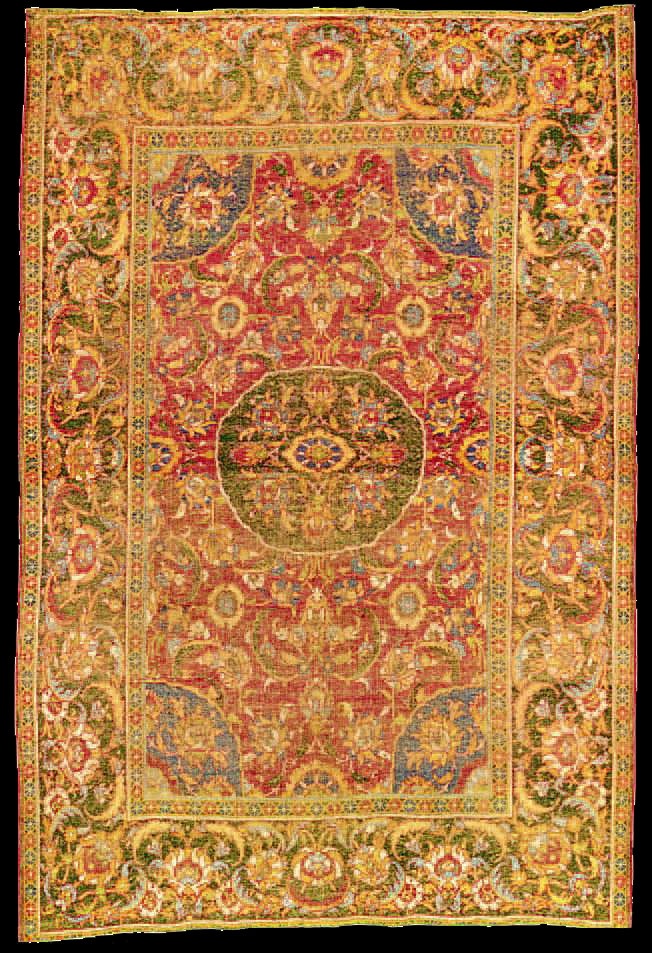The Bernheimer Ottoman medallion rug. Cairo, Egypt, 16th century
currently the Museum of Islamic Art in Doha, Qatar no.CA63
Price Realized £33,460 ($59,124)
Sale Information
Christies SALE 6897 —
ORIENTAL RUGS AND CARPETS
29 April 2004
London, King Street
Lot Description
A CAIRENE RUG
OTTOMAN EGYPT, 16TH CENTURY
The wine-red field with scrolling palmette and flowering vine around a
central grass-green roundel containing palmettes radiating from a central
rosette, the blue spandrels similar, in a grass-green border of palmettes
and vine issuing scrolling serrated saz leaves between golden yellow
flowerhead stripes, areas of wear, outer stripe missing at each end,
selvages rebound, corroded black, very small repairs
6ft.3in. x 4ft.4in. (191cm.x 132cm.)
Provenance
Otto Bernheimer, acquired 8 April 1919 as an "Ispahan"
The Berheimer Family Collection of Carpets, Christie's, London, 14 February
1996, lot 83
Literature
Erdmann, Kurt: Der Orientalische Knüpfteppich, Tübingen, 1955, no.130
Alte Teppiche des 16.-18. Jahrhunderts der Firma L. Bernheimer, Munich,
1959, pl.5
Yetkin, Serare: Historical Turkish Carpets, Istanbul, 1981, p.116, illus. 73
Exhibited
Ausstellung Orient-Teppiche: Museum für Kunst und Gewerbe, Hamburg, 1950,
no.9, pp.22-23, pl.8
Lot Notes
This rug belongs to the second major group of carpets attributed to Cairo
and represents the union of two distinct cultures, namely the Mamluks and
the Ottoman Turks, after the 1517 Ottoman conquest of the Mamluk Sultanate.
While this rug's "S" (clockwise)-spun/"Z" (anti-clockwise)-plied wool and
its limited palette link it to the earlier tradition of Mamluk carpets, its
elaborate design is purely Ottoman Turkish. As with the Mamluk group, the
Cairo attribution for these rugs has been contested in existing carpet
literature, with some scholars believing them to be of Bursa or Istanbul
production. It is generally accepted today that the earliest examples of the
group were made in Cairo, adapting an Ottoman design aesthetic with
traditional Mamluk materials and that either later or contemporaneous rugs
with similar designs were woven in Turkey proper. The combination of Mamluk
techniques and materials with Ottoman designs dates this group of rugs to
after the 1517 conquest and their production most likely continued into the
early seventeenth century (see Pinner, R. and Franses, M.: "East
Mediterranean Carpets in the Victoria & Albert Museum," Hali, Vol. 4, no. 1,
1981, pp.39-40). The joining of these two artistic traditions has created
weavings that are among the most elegant carpets surviving today.
As both Erdmann and Yetkin point out, the design of the present rug
demonstrates an unusual characteristic of the relationship between field
pattern and the medallions and corner spandrels sometimes seen in Ottoman
carpets. Here the medallion and spandrels are superimposed on the endless
repeating floral lattice of the field without any cohesion or allowance in
the field design for the medallion/spandrel elements (see Erdmann, op. cit.,
p.50 and Yetkin, op. cit., pp.113-120).
The individual design elements of the medallion, field and border of this
rug are fairly typical of the Ottoman Cairene repertoire and can be seen in
different manifestations in several other examples, such as another rug
formerly in the Bernheimer's possession (Erdmann: op. cit., no.131), a rug
in the collection of Prince Paar, Vienna (Yetkin: op. cit., p.121, illus.
74) and a rug formerly in the collection of Susan and Lewis Manilow, sold
Sotheby's New York, 7 April 1992, lot 86.
Similar to their Mamluk cousins, very few Ottoman Cairene rugs seem to have
been depicted in Western paintings, perhaps because of their complex
patterning and muted coloration. They were, however, extremely popular with
European collectors in the late sixteenth and early seventeenth centuries
and many Cairene rugs appear listed in European collection inventories of
the period (see King, Donald and Sylvester, David: The Eastern Carpet in the
Western World from the 15th to the 17th Century, London, 1983, p.79). The
popularity of Ottoman Cairene has continued with Western collectors, in both
Europe and the United States, from the early part of this century until
today as demonstrated by their inclusion in most major carpet collections of
this period. |

|

